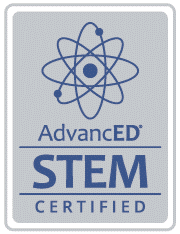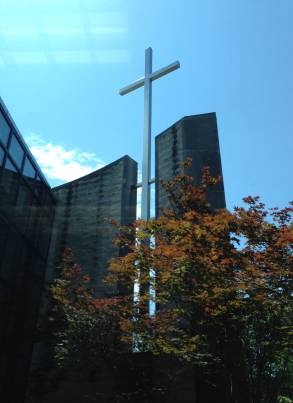Test everything. Test everything. Test everything...In every condition! - David King ‘20
— RHS Science (@SciRHS) May 10, 2019
— RHS Science (@SciRHS) May 10, 2019
After a year’s worth of work, David King’s project was almost completely ruined. Anticipating a worldwide shortage of helium, as it turns out, wasn’t one of the learning objectives for this high school junior’s course objectives. However, with a little help from Larry Egan, class of 1981, this Fundamentals of Science Research project survived - 100,000+ feet survived! Thank you Helget Gas!
Searching the Heavens has long been a tradition of Catholic Jesuits since the inception of the Society of Jesus. The Vatican Observatory has always been run by members of the Society of Jesus. When the Vatican Astronomer Brother Guy Consalmagno, S.J. visited Rockhurst, he implored to the students that studying the universe is equivalent to studying God’s creation and, therefore, is a form of worship. When the director of the Vatican Observatory, Fr. David Brown, S.J., visited Rockhurst he spoke about how both faith and reason work together. So does it surprise anyone that a junior in a Catholic, Jesuit High School would want to send a camera up into the heavens? And tweet out pictures in real time!?
one picture from near apogee pic.twitter.com/TPoXMJD6js
— RHS Science (@SciRHS) May 11, 2019
David King’s project is just one of 17 individual student research projects that were conducted in the 2018-2019 Fundamentals of Science Research class.
I sat down with David to ask him a few questions about his project. His answers follow:
Me: What was your research?
David: The abstract of the project was to look into the viability and the best practices for the construction and operation of a tracking system for a High Altitude Balloon. The system integrated a RasberryPi and a Radiometrix Hx1 to gather sensor data of the balloon. In reality, what happened was that I used a 360 Fly camera to record 360 video.
The 360 video is quite stunning. Check it out on YouTube below:
Me: What did you build and design on your own?
David: I built the sonde [the container that holds the payload]. I also built the entire sensor stack using the RaspberryPi, which included sensors for temperature, barometric pressure, altitude, latitude, visible light, infrared light, ultraviolet light and humidity.
— RHS Science (@SciRHS) May 10, 2019
Me: Tell me about the launch.
David: We launched the balloon after school on Friday, May 10th. The balloon officially launched at 3:24 pm and landed at 7:51pm. It reached 103,000 feet at its highest point. The ascent took about two hours and the descent was about 1 hour.
Launch video is below:
This is a picture from the highest point of flight, at 103,000 ft pic.twitter.com/1AEwRlI4FT
— RHS Science (@SciRHS) May 12, 2019
Me: What did you need to learn along the way?
David: I had to learn how to program in Python so that the RaspberryPi would collect and transmit all the data. I also had to learn a bunch of “weather type thing”. It turns out that there are all sorts of various wind currents that take place at various heights. And related to both of those things, I learned a bunch of HAM Radio stuff.
Me: Tell me more about how you tracked the balloon.
David: Inside of the sonde, there was a pre-built trackuino. After the launch, my classmate Jack Rotter and I rode in Mr. Nendick’s car with our computers open. We set up a GQRX that was connected to the Balloon’s trackuino. As data was transmitted in an encoded format and we had to decode the messages into positional data. We actually did this by hand. The first numbers represented the degree, followed by minutes, then seconds. We then inputted that data into Google Earth, which we had downloaded onto our devices. We just drove from there. We were actually a quarter of a mile off from where the balloon actually landed so I had to redo some calculations.
15,000 over Lake Lee’s Summit! Still climbing high! pic.twitter.com/58oiaCzKO2
— RHS Science (@SciRHS) May 10, 2019
Me: How did you know you were not in the right spot?
David: We were not hearing the beep from the peazzo buzzer inside of the balloon. It was programmed to beep about every 4 seconds. We also may or may not have been chased by some local cows, so that was also a hint we were not where we were supposed to be!
Me: What were some major challenges you faced along the way?
David: I didn’t anticipate a worldwide shortage of Helium. I was cold calling companies, but kept striking out. Luckily, Mr. Egan saved the entire project. After that, it turns out that my MFSK didn’t work on launch day, which was really disappointing. I tested it so many different ways and in various locations; however, in retrospect I realized that I never tested it outside of a wifi connection and there was a glitch that I couldn’t debug on the spot. If I could do it over again, then I would choose to launch on a Saturday so I would have more time. I could have debugged that mistake before pumping the helium into the balloon. Once I realized what was happening, however, I couldn’t go back because we had already filled the balloon with helium.
Weather balloon successfully recovered pic.twitter.com/u1FHAg5dlT
— RHS Science (@SciRHS) May 11, 2019
Me: Would you do it again?
David: Yes! I enjoyed it a lot and it was fun to do. It was just a good challenge.
Me: What is your advice to future students who may embark on a similar project or experience?
David: Test everything. Test everything. Test everything…In every condition!
Me: Thanks for sharing your story, David. Congratulations on a successful launch and I’m glad you were able to get the pictures and video data after the fact, even if it didn’t transmit live.
David: Thank you.
Recovered 360 video from flight pic.twitter.com/nYVTml6NVW
— RHS Science (@SciRHS) May 11, 2019
This class demands students try things they’ve never done before and publicly share their results - whatever they may be. I’m less concerned with a student producing objectively novel or deeply challenging projects, and rather seeing a project through from inception to presentation and truly owning each stage of the research process. At its heart, this class is about ‘saying yes, then finding a way’. -Mr. Tim Nendick ‘07 and teacher of the Fundamentals of Science Research course
Mr. Nendick’s quote above echoes the “call of the King”. As Ignatian educators we hope to bring students closer to Jesus Christ through inpsiring them to be the person God created them to be. We want our students to be moved with inspiration and recognize God’s presence in all things. I’ll end this post with a beautiful description of this call of the King by Fr. Kevin O’Brien, S.J. He does a wonderful job of artriculating the crucial mission of Ignatian educators.




Comments